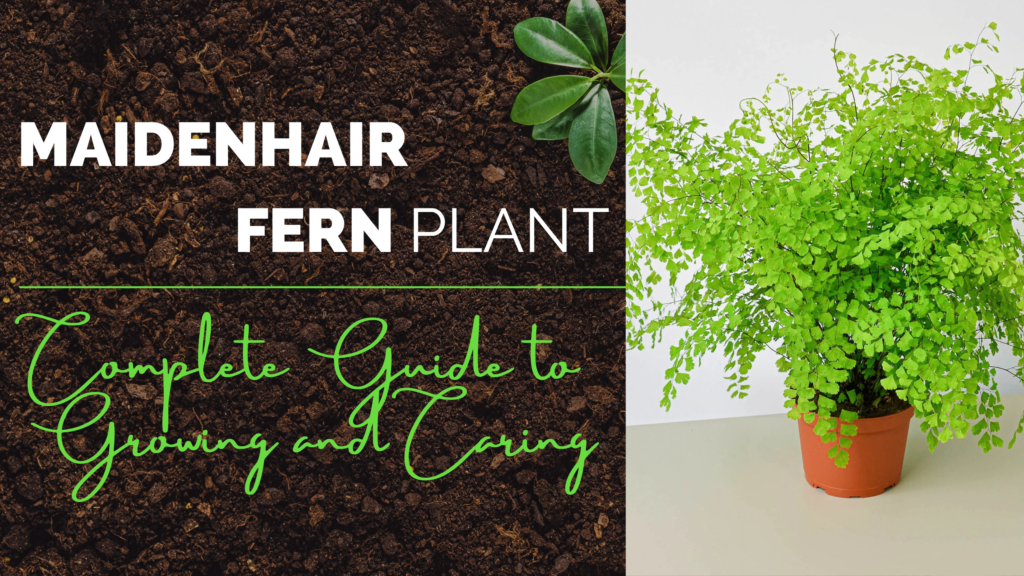
If you’ve ever walked into a nursery and spotted a delicate fern with fan-shaped leaves dancing on the wiry black stems, the chances are you’ve met the Maidenhair Fern (Adiantum). People either fall in love with it instantly or shy away after hearing it’s “too hard to keep alive.” The truth? Yes, it’s a bit fussy, but once you understand what it needs, it can be one of the most rewarding plants in your collection.
I learned this the hard way. My very first maidenhair fern turned crispy within two weeks because I treated it like a pothos — watering once in a while and leaving it near a sunny window. It wasn’t until I did my research (and killed one more, I’ll admit!) that I cracked the code. Today, my maidenhair has been thriving in my bathroom for nearly two years, and it still greets me with fresh green fronds every morning.
So let’s break down everything you need to know about the maidenhair fern plant — from light and water to soil, fertilizer, and even how to revive one when it looks hopeless.
📖 Maidenhair Fern Scientific Name
The scientific name of the commonly grown Maidenhair Fern is Adiantum raddianum. Belonging to the Pteridaceae family, this fern has more than 200 species, all sharing that distinctive fan-shaped leaf pattern.
🌿 Maidenhair Fern Plant Benefits
Beyond being beautiful, Maidenhair Ferns have a few hidden perks:
Air Purification: Like many indoor plants, they help filter indoor air and create a fresher environment.
Mood Booster: Their soft, lace-like leaves bring a calming, natural vibe to your space, reducing stress and boosting focus.
Natural Humidifier: Since they love and release moisture, having one indoors can improve air humidity levels — perfect if you live in a dry climate.
Decor Value: Whether perched on a shelf or hanging in a basket, they instantly elevate the look of your home.
I still remember when I brought my first Maidenhair Fern into my study. Within weeks, friends commented on how “alive” the room felt — proof that some plants just bring a unique energy.
The Right Light: Bright but Gentle
One of the first mistakes I made was giving my fern direct sun. Its fragile fronds scorched within days.
Here’s the trick: bright, indirect light is best. A north- or east-facing window is perfect. If you only have a south or west window, pull the plant back a few feet or use a sheer curtain. Outdoors, it loves a cool, shaded corner.
Think of its natural habitat — nestled among rocks, close to waterfalls, in filtered light. That’s what you’re trying to recreate indoors.
Dieffenbachia (Dumb Cane) – How to Grow and Care for it
Watering: Moist but Never Soggy
If maidenhair ferns could talk, they’d say: “Don’t let me dry out, but don’t drown me either.”
⦁ Check daily: Stick your finger in the soil. If the top feels slightly dry, it’s time to water.
⦁ Use room-temperature water: Cold shocks the roots; lukewarm works better.
⦁ Avoid waterlogging: Make sure the pot drains well. Empty saucers after watering.
A self-watering pot can make life much easier because it keeps soil consistently moist without leaving roots sitting in water. I switched to one last summer, and my fern hasn’t thrown a tantrum since.
Humidity: The Secret Sauce
This plant loves humidity. If your fern keeps getting crispy tips, it’s crying for more moisture in the air.
Here’s what works:
⦁ Place it in a bathroom or kitchen, where humidity is naturally higher.
⦁ Group it with other plants to create a mini-jungle effect.
⦁ Use a humidifier or a pebble tray filled with water.
⦁ Mist lightly, but don’t drench — too much mist on leaves can encourage fungus.
In Chennai’s coastal humidity, your fern will thank you, but during drier months or in AC rooms, you’ll still need extra help.
Choosing the Right Pot and Soil
Not all pots are created equal for maidenhair ferns.
⦁ Best choice: Plastic or glazed ceramic pots, since terracotta dries out too quickly.
⦁ Size rule: Go only one size bigger when repotting. Oversized pots hold excess water and lead to root rot.
⦁ Potting mix: A blend of premium indoor potting soil with coco peat or compost works wonders. Coco peat, in particular, holds moisture without turning muddy.
When I repotted mine into a mix with coco peat and perlite, the difference was night and day. The soil stayed moist longer, but roots didn’t suffocate.
Feeding Your Fern
Unlike succulents, maidenhair ferns appreciate a little feeding.
⦁ Liquid fertilizer: Use a balanced, diluted liquid feed every 2–4 weeks in spring and summer.
⦁ Controlled release pellets: Add a slow-release fertilizer at the start of the growing season.
⦁ Foliar sprays: Some gardeners swear by mist-and-feed sprays that deliver nutrients directly to the fronds.
Tip: Always fertilize lightly. Too much nitrogen burns leaf tips. I learned this after getting overenthusiastic with fertilizer one year!
Pruning and Reviving
Even with the best care, fronds age, dry out, or get crispy. Don’t panic. Just snip them off at the base. This encourages new growth.
And here’s the magic part: if your whole plant looks dead, cut back all fronds to soil level, water it well, and keep it in a humid, shaded spot.
In many cases, it will bounce back with fresh shoots. I revived one this way, and honestly, watching those new fronds unfurl was one of the most satisfying plant moments I’ve had.
Maidenhair Fern Plant Care
Caring for a Maidenhair Fern isn’t impossible, but it does require consistency. Think of it like adopting a pet — a little attention goes a long way.
⦁ Light: Maidenhair ferns dislike direct sunlight, which can scorch their fragile fronds. Instead, they thrive in bright, indirect light. A spot near an east-facing window or a shaded balcony is ideal.
⦁ Watering: The golden rule? Never let the soil dry out completely. Keep it moist but not soggy. Using a self-watering pot or adding coco peat to the soil helps maintain steady moisture.
⦁ Humidity: These ferns adore humidity. Bathrooms with natural light or kitchens can be perfect. If the air is dry, mist the leaves or place a tray of water nearby.
⦁ Soil: A loose, well-draining mix with organic matter is best. Adding coco peat or perlite improves water retention while preventing root rot.
⦁ Fertilizer: Feed lightly during spring and summer with a diluted liquid fertilizer once a month. Too much fertilizer can damage the delicate roots.
⦁ Pruning: Trim away yellow or dried fronds to encourage fresh growth. Don’t be afraid — Maidenhair ferns bounce back quickly when given proper care.
🌱 Maidenhair Fern Plant Propagation
Propagating Maidenhair Ferns is slightly trickier than with some other houseplants, but it’s doable.
⦁ Division Method: The easiest way is to gently divide the root ball when the plant outgrows its pot. Use a clean knife to separate a healthy clump with roots attached and replant it in fresh soil.
⦁ Spores: Advanced gardeners sometimes propagate through spores found on the underside of fronds. This method takes longer and requires patience, but it’s a fun experiment if you’re up for it.
Tip: Always propagate in spring or early summer when the plant is actively growing.
🏡 Maidenhair Fern Plant Indoor
Indoors is where Maidenhair Ferns really shine. They’re popular as houseplants because of their elegant look, but they need a bit of pampering.
⦁ Place them in bright but indirect light (too little light = weak fronds; too much = scorched leaves).
⦁ Bathrooms with windows are perfect — the natural humidity helps prevent crispy fronds.
⦁ Avoid placing them near heaters, air conditioners, or drafty windows.
⦁ If your indoor air is dry, consider using a humidifier or grouping plants together to create a microclimate.
Many plant lovers agree: the Maidenhair Fern is one of the most rewarding indoor plants, once you find the right spot for it.
🌳 Maidenhair Fern Plant Outdoor

Can you grow Maidenhair Ferns outdoors? Absolutely — if your climate allows.
⦁ Outdoors, they love cool, shaded spots with consistent moisture. Think under trees, on shaded patios, or along garden borders.
⦁ In hot or dry regions, they may struggle outside unless you provide shade and regular watering.
⦁ Protect them from strong winds and scorching midday sun.
Gardeners in tropical and subtropical areas often grow them outdoors year-round. In cooler climates, you may need to bring them inside during winter.
⚠️ Maidenhair Fern Problems
Even the most devoted plant parents encounter hiccups. Here are common issues and quick fixes:
⦁ Crispy or brown fronds: Usually caused by low humidity or underwatering. Increase misting or place near a humidifier.
⦁ Yellowing leaves: Often a sign of overwatering or poor drainage. Check the soil and cut back on watering slightly.
⦁ Drooping fronds: This can happen if the plant has completely dried out. Trim back dead growth, rehydrate the soil, and be patient — new shoots often appear.
⦁ Pests (rare): Occasionally aphids or scale may attack. Wipe leaves gently and use an organic insecticidal soap if needed.
Remember: Maidenhair ferns are resilient. Even if they look half-dead, trimming and proper care can bring them back to life.
Dracaena Plant: A Complete Guide to Care, Benefits, and Varieties
How to Grow Pistachios: From Seed to Snack
Coreopsis: How to Grow and Care for It
Final Thoughts
Owning a maidenhair fern is like having a high-maintenance but rewarding friend. It asks for attention, but it gives back in lush, graceful beauty. Once you create the right environment — consistent moisture, indirect light, and high humidity — the “fussy” reputation fades away.
If you’ve killed one before, don’t give up. With a little patience and the right setup, you can enjoy this elegant plant for years. Mine has taught me not just about plant care but about paying attention, slowing down, and creating consistency — lessons that spill over into life, too.
FAQs About Maidenhair Ferns
1. Is the maidenhair fern plant hard to care for?
It has a reputation for being fussy, but if you keep the soil moist, give it indirect light, and provide humidity, it’s manageable.
2. Can maidenhair ferns grow in bathrooms?
Yes, bathrooms are actually ideal because of the natural humidity. Just make sure that there’s some indirect light.
3. How often should I water my maidenhair fern?
Check daily. Most of them need watering every 1–3 days, depending on your climate and pot size. Never let the soil dry out completely.
4. Why are the leaves on my maidenhair fern turning brown?
Usually because of low humidity or underwatering. Increase humidity and keep the soil consistently moist.
5. Can I revive a dead-looking maidenhair fern?
Often, yes. Cut all fronds back to the soil, keep it moist, and place it in a humid, shaded spot. Many bounce back within weeks.

